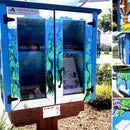Introduction: Gorgeous Hand Painted Bracelet
You can make a stunning hand painted bracelet like this one, using just a few simple painting and jewelry making techniques. And it's not only beautiful, but is also very durable due to resin overlays. I will go over the basic instructions, though you can make all the creative decisions. I hope you enjoy this project!
Attachments
Step 1: What You Need
Premade bezels with two loops (See note in next step.)
4-6mm open jump rings (See note in next step.)
At least 1 open or closed jump ring that the clasp fits on
1 lobster claw or spring ring clasp
Acrylic paints - 2-5 colors of your choice. You only need a few drops of each color
Clear epoxy resin (about a 1/2 tsp per bezel)
Paint brush
Toothpicks
Small mixing cup for resin
Wax paper to work on
2 pairs of jewelry pliers (flat nose and/or chain nose )- you can make do with one pair, but 2 will be easier
Step 2: A Note on Bezels & Jump Rings
BEZELS
Any plain bezel trays (also known as bezel cups) with two loops each will work for this project. You can find them online in many colors and sizes. This bracelet will work best with 14mm - 25mm trays. How many you need will be determined by the size of the trays and the size you want your finished bracelet. The trays are fairly inexpensive so it's best to buy extras so you can work out the sizing and allow for mistakes. If you're not sure what to buy, get a dozen 20mm trays.
You can find a good selection of bezel trays here:
http://www.rings-things.com/Products/2-Loop-Bezel-...
JUMP RINGS
The jump rings will be used to join the loops on the bezel trays into a bracelet. The joins can be as simple as one ring between each tray, or rings can be made into lengths of decorative chainmail. The longer the lengths are, the fewer trays you will need. Beginners should use the single ring approach.
I made very short lengths of byzantine chain to join my bezel trays. This is a more advanced approach. You can Google "byzantine chainmail" to find the pattern, if you want to try it.
Also, you will need at least 1 or more jump rings that are large enough for the clasp to attach on to.
The number of jump rings you need is determined by how you decide to join the trays, how large the trays are, and how large the rings are. If you're not sure, grab 2 dozen 6mm rings.
Note: Don't buy rings made of a soft metal like aluminum for this project or your bracelet may pull apart.
Step 3: Base Paint
(Pretend the bezels in these photos have 2 loops)
Paint the inside of each bezel with a layer of acrylic paint. Make sure to paint the inside side walls.
Let dry.
Step 4: Add More Paint
(Again, pretend the bezels in these photos have 2 loops)
Pour or squeeze a dot of each color paint you'll be using into each bezel. Only work on a couple of trays at a time, so the paint stays wet while you work.
Step 5: Get Artsy!
Use clean toothpicks to drag the colors into each other. You can create zig-zags, swirls, spirals, lightening bolts etc. I use toothpicks because the trays are so small that paintbrushes just make a mess.
You can add more paint if what you have doesn't cover the bottom of the tray.
Attachments
Step 6: More Painting
Set up a palette (a few drops of each color on a piece of wax paper).
Use the paint on this "palette" to detail your tiny artwork. Dip a toothpick into the drops of color to dab onto your wet painting and create accents, dots, and other designs. Paint until your happy with your finished artwork.
Attachments
Step 7: Dry Fully
Let the paint dry completely. This may take a day or more, depending on how thick your tray paintings are.
Note: Don't worry if the paint cracks or looks dull. Adding resin will fix these problems.
Step 8: Resin
You will seal each tiny painting with epoxy resin.
Set a sheet of wax paper on a flat work surface (I use a cutting board). Mix the resin according to the package instructions. (You will need an ounce or two of mixed resin, depending on the size and number of trays you'll be filling.)
Optional: Set each bezel on a few coins to raise them up a little.
Fill each bezel tray with enough resin that the resin just barely forms a dome, but doesn't drip over the edges. If your trays are very small, drip the resin into the trays with toothpicks.
Let the resin set and thicken up before moving.
Attachments
Step 9: Ready to Work With...
The resin should be 100% cured - hard and dry - before beginning assembly. The fronts and backs look like this.
Attachments
Step 10: Plan
Measure the wrist that this bracelet is intended for, and add a little extra so it's not too snug. (About 1/3" should be plenty.)
Then lay out the bezel trays in a line, with a little room between each one. Lay the large jump ring at one end, and the clasp at the other end. Now measure. This will give you an idea of how close you are to the size you want your finished bracelet.
Make adjustments.
You can add or subtract trays if your sizing is way off.
If it's just a little off, make adjustments with the jump rings. Smaller rings will make the bracelet smaller, bigger rings will make it bigger.
If you decide to make chainmail links, account for the size by making one link and measuring. Then add that measurement to the gaps between each of the trays. You will need fewer bezel trays, if you make chainmaill links.
Note: You can make the bracelet size adjustable by adding extra jump rings to the end to have a choice of where to clasp the bracelet. Just make sure the smallest option isn't too big.
Attachments
Step 11: Assemble
Using a plier in each hand, twist open a jump ring just enough so that the opening fits over a bezel tray loop. Pick two adjacent bezel trays and slide the loops onto the jump ring so that they remain in the order you planned out. Twist the jump ring closed.
Repeat with all the bezel trays until they are joined together into a single line.
Attachments
Step 12: Clasp
Now add one more opened jumping to the end of the trays. Add the clasp and close the jump ring.
Note: My photo shows how I use a piece of wire to keep my chainmail together while I work. You won't need to do this if you're using the single ring approach.
Attachments
Step 13: More Rings
At the other end of the bracelet you will need to add the larger jump ring for the clasp to attach to. You can be finished at this point, or continue with the instructions below.
I added about a 1/2" of jump rings in a line - each ring opened, attached, and closed, on to the ring before it. This added 1/2" of adjustability to the bracelet length. (This was especially important for this particular bracelet since I didn't know the size of the person who would be wearing it.)
Attachments
Step 14: Back of the Finished Bracelet
The back should be smooth and attractive.
Step 15: Leftover Bezel Trays
If you have more trays than you could use for the bracelet, try making a pair of matching earrings.
I added carnelian tear drops and gold-plated ear wires to make a gorgeous pair of matching dangle earrings.
I have a number of earring tutorials here:
Attachments
Step 16: Ready to Wear!
I hope you enjoyed this tutorial!
I'd love to see what you create, so please share photos of your projects :-)
Attachments

Second Prize in the
Paint Challenge














